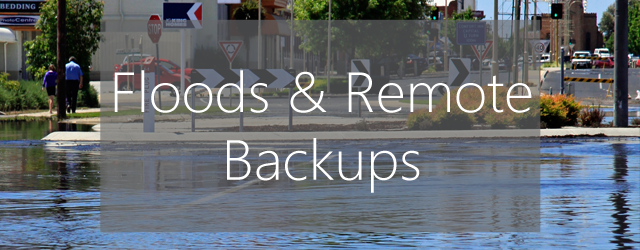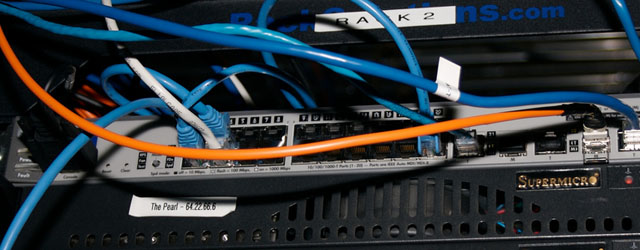
I grew up in a small town towards the north of Australia. Every few years or so, the wide river that snaked through our town would swell with monsoonal rains and break its banks, spilling across the two bridges that brought the town together. Kids like me would be cut off from school – which of course we didn’t mind – but business owners would find their offices and staff scattered and divided.
Thinking on the hypothetical of how we’d deal with being cut off from our office or threatened with disaster brought me around to the reality of how we and many of our customers protect their businesses: remote backups.
Not too long ago, remote backups were prone to connection problems, notoriously complicated and prohibitively expensive to all but the largest of businesses. Now they are pervasive. Consumer backup solutions like Dropbox and Drive are everywhere.
Of course BackupAssist is no stranger to remote backups, whether onsite or offsite, and this article explores some of the ways you can perform these with BackupAssist. We’ll look at ways you can create remote backups within your organisation and ways you can haul data offsite to keep it safe.
Onsite and Offsite remote backups: How-to with BackupAssist

Central Admin
Let’s face it, there are plenty of reasons to perform remote onsite backups. You might want to move data from a rickety but necessary old server to a RAID-10 NAS in a Fort Knox like safe room. Or you might not want to keep trudging down the hall, past the toilets, to the permafrost of the server room
Well, an easy way to create remote onsite backups within your LAN area is to use Central Administration, which is included with the basic BackupAssist license. Central Administration lets you remotely access your installations of BackupAssist from a web browser in your LAN.
To set up Central Administration:
- Start BackupAssist
- Select the Remote tab, and then select Central Administration Setup
- Tick Enable Central Administration
- Create a new remote administrator account by filling in the Username and Password fields
- Tick Enable remote console access
- Copy the Open in browser link
There’s more detail on all the options when setting up over at our Central Administration Whitepaper.
Once you’ve set up Central Administration across all of your backup machines, go back to your desk, relax, maybe get a cup of coffee or two, then open up your web browser.
Paste the link into your address bar and log in. When you’re in, go to the Computers tab, choose Add New and add all the additional instances of BackupAssist. You’re now able to run jobs, monitor backups and check the reports for all the installs that you added. But that’s not the best part…
The Remote Console
Central Administration also has a really neat feature: you can create and run backups for all those machines that we added, all from the comfort of your Aeron Ergonomic chair. To get your remote onsite backups happening:
- Select the machine you want to remotely connect to from the Computers screen
- Select, Open BackupAssist Console
- BackupAssist will start locally and run as a remote session for the selected machine.
- To run the remote session we need a .BAR file which will start to download automatically on opening the remote session.
- Your browser might ask if you want to keep the file or something similar. Accept if you want to get the remote session going and then open the file.
- You’ll be asked to sign into the BackupAssist install that you are remotely accessing. Sign in using the credentials that you set up on the machine earlier.
- You’re in! You’ve now got free reign to create and run new backups till your heart’s content.
Rsync

The benefits of remote offsite backups speak for themselves. Reduced costs, scalability and extra levels of redundancy are all great reasons. So is protection from disasters. That’s pretty much the main reason we, and everyone we’ve spoken to, keeps data off-site.
In BackupAssist, we use the tried-and-tested Rsync protocol to enable remote offsite backups such as shunting files to cloud providers. With Rsync preconfigured to work with S3Rsync, a company that does all the fiddly work of setting up Rsync with Amazon’s S3 cloud, it’s really easy to move data and backups offsite.
Setting up an Rsync internet backup
- Create a new File Protection job.
- Choose the data you want to backup in the Selection screen.
- Select Rsync or S3Rsync for your backup destination, and click Next. The S3Rsync option is for backups to Amazon S3 via the s3rsync.com service and the Rsync option is for all others.
- If you want to keep your data secure before dumping it on another company’s servers – which you really should – select Enable Rsync file based encryption which will encrypt your data before it’s is sent.
- Choose the job’s from one of the pre-configured schedules. You can go back after the job’s been created and fine tune the schedule if your needs are more complex.
- Configuring your Rsync destination will depend on whether you selected Rsync or S3Rsync. Set up your Rsync connection as per the details you got when you signed up with S3Rsync and AWS. If you haven’t signed up you can do that here.
- Once you have set up your Rsync destination, click Next
- Provide a name for your backup. Click Finish. Ta-da! Ready to Rsync across the big wide world or even just across the road.